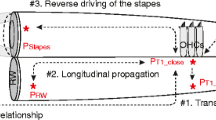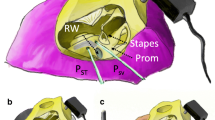ABSTRACT
In a healthy cochlea stimulated with two tones f 1 and f 2, combination tones are generated by the cochlea's active process and its associated nonlinearity. These distortion tones travel “in reverse” through the middle ear. They can be detected with a sensitive microphone in the ear canal (EC) and are known as distortion product otoacoustic emissions. Comparisons of ossicular velocity and EC pressure responses at distortion product frequencies allowed us to evaluate the middle ear transmission in the reverse direction along the ossicular chain. In the current study, the gerbil ear was stimulated with two equal-intensity tones with fixed f 2/f 1 ratio of 1.05 or 1.25. The middle ear ossicles were accessed through an opening of the pars flaccida, and their motion was measured in the direction in line with the stapes piston-like motion using a laser interferometer. When referencing the ossicular motion to EC pressure, an additional amplitude loss was found in reverse transmission compared to the gain in forward transmission, similar to previous findings relating intracochlear and EC pressure. In contrast, sound transmission along the ossicular chain was quite similar in forward and reverse directions. The difference in middle ear transmission in forward and reverse directions is most likely due to the different load impedances—the cochlea in forward transmission and the EC in reverse transmission.









Similar content being viewed by others
REFERENCES
Aibara R, Welsh JT, Puria S, Goode RL (2001) Human middle-ear sound transfer function and cochlear input impedance. Hear Res 152:100–109
Cheng JT, Harrington E, Furlong C, Rosowski JJ (2011) The tympanic membrane motion in forward and reverse middle-ear sound transmission. In: Proceedings of the 11th International Mechanics of Hearing Workshop, 16–22 July 2011, Williamstown, pp. 158–163
Dalhoff E, Turcanu D, Gummer AW (2011) Forward and reverse transfer functions of the middle ear based on pressure and velocity DPOAEs with implications for differential hearing diagnosis. Hear Res 280:86–99
Dancer A, Franke R (1980) Intracochlear sound pressure measurements in guinea pigs. Hear Res 2:191–205
de La Rochefoucauld O, Olson ES (2010) A sum of simple and complex motions on the eardrum and manubrium in gerbil. Hear Res 263:9–15
de La Rochefoucauld O, Decraemer WF, Khanna SM, Olson ES (2008) Simultaneous measurements of ossicular velocity and intracochlear pressure leading to the cochlear input impedance in gerbil. J Assoc Res Otolaryngol 9:161–177
de La Rochefoucauld O, Kachroo P, Olson ES (2010) Ossicular motion related to middle ear transmission delay in gerbil. Hear Res 270(1–2):158–72
Decory L, Franke RB, Dancer AL (1990) Measurement of middle ear transfer function in cat, chinchilla and guinea pig. In: Dallos P, Geisler CD, Matthews JW, Ruggero MA, Steele CR (eds) The mechanics and biophysics of hearing. Springer, Berlin, pp 270–277
Decraemer WF, de La Rochefoucauld O, Dong W, Khanna SM, Dirckx JJ, Olson ES (2007) Scala vestibuli pressure and three-dimensional stapes velocity measured in direct succession in gerbil. J Acoust Soc Am 121:2774–2791
Decraemer WF, de La Rochefoucauld O, Olson ES (2011) Measurement of the three-dimensional vibration motion of the ossicular chain in the living gerbil. In: Shera CA, Olson ES (eds) What fire is in mine ears: progress in auditory biomechanics. American Institute of Physics, Melville, pp 164–169
Dong W, Olson ES (2005) Two-tone distortion in intracochlear pressure. J Acoust Soc Am 117:2999–3015
Dong W, Olson ES (2006) Middle ear forward and reverse transmission in gerbil. J Neurophysiol 95:2951–2961
Dong W, Olson ES (2008) Supporting evidence for reverse cochlear traveling waves. J Acoust Soc Am 123:222–240
Keefe DH (2002) Spectral shapes of forward and reverse transfer functions between ear canal and cochlea estimated using DPOAE input/output functions. J Acoust Soc Am 111:249–260
Keefe DH, Abdala C (2007) Theory of forward and reverse middle-ear transmission applied to otoacoustic emissions in infant and adult ears. J Acoust Soc Am 121:978–993
Kemp DT (1978) Stimulated acoustic emissions from within the human auditory system. J Acoust Soc Am 64:1386–1391
Magnan P, Avan P, Dancer A, Smurzynski J, Probst R (1997) Reverse middle-ear transfer function in the guinea pig measured with cubic difference tones. Hear Res 107:41–45
Nakajima HH, Olson ES, Mountain DC, Hubbard AE (1994) Electrically evoked otoacoustic emissions from the apical turns of the gerbil cochlea. J Acoust Soc Am 96:786–794
Nakejima HH, Dong W, Olson ES, Merchant SN, Ravicz ME, Rosowski JJ (2008) Differential intracochlear sound pressure measurements in normal human temporal bones. J Assoc Res Otolaryngol 10:23–36
Nedzelnitsky V (1980) Sound pressures in the basal turn of the cat cochlea. J Acoust Soc Am 68:1676–1689
Olson ES (1998) Observing middle and inner ear mechanics with novel intracochlear pressure sensors. J Acoust Soc Am 103:3445–3463
Olson ES (2001) Intracochlear pressure measurements related to cochlear tuning. J Acoust Soc Am 110:349–367
Puria S (2003a) Measurements of human middle ear forward and reverse acoustics: implications for otoacoustic emissions. J Acoust Soc Am 113:2773–2789
Puria S (2003) Middle-ear two-port measurements in human cadaveric temporal bones: comparison with models. Proceedings of the 3rd Symposium on Middle Ear Mechanics in Research and Otology, Japan, World Scientific, pp. 43–50
Puria S, Rosowski JJ, Peake WT (1993) MIddle ear pressure gain in humans: preliminary results. World Scientific, Singapore
Puria S, Peake WT, Rosowski JJ (1997) Sound-pressure measurements in the cochlear vestibule of human-cadaver ears. J Acoust Soc Am 101:2754–2770
Ravicz ME, Rosowski JJ, Viogt HF (1992) Sound-power collection by the auditory periphery of the Mongolian gerbil Meriones unguiculatus. I: Middle-ear input impedance. J Acoust Soc Am 92(1):157–77
Ravicz ME, Rosowski JJ, Viogt HF (1996) Sound-power collection by the auditory periphery of the Mongolian gerbil Meriones unguiculatus. II: External-ear radiation impedance and power collection. J Acoust Soc Am 99(5):3044–63
Ravicz ME, Cooper NP, Rosowski JJ (2008) Gerbil middle-ear sound transmission from 100 Hz to 60 kHz. J Acoust Soc Am 124:363–380
Rosowski JJ, Cheng JT, Ravicz ME, Hulli N, Hernandez-Montes M, Harrington E, Furlong C (2009) Computer-assisted time-averaged holograms of the motion of the surface of the mammalian tympanic membrane with sound stimuli of 0.4-25 kHz. Hear Res 253:83–96
Slama MC, Ravicz ME, Rosowski JJ (2010) Middle ear function and cochlear input impedance in chinchilla. J Acoust Soc Am 127:1397–1410
Teoh SW, Flandermeyer DT, Rosowski JJ (1997) Effects of pars flaccida on sound conduction in ears of Mongolian gerbil: acoustic and anatomical measurements. Hear Res 106:39–65
Tonndorf J, Khanna SM (1972) Tympanic-membrane vibrations in human cadaver ears studied by time-averaged holography. J Acoust Soc Am 52:1221–1233
Voss SE, Shera CA (2004) Simultaneous measurement of middle-ear input impedance and forward/reverse transmission in cat. J Acoust Soc Am 116:2187–2198
Withnell RH, Kirk DL, Yates GK (1998) Otoacoustic emissions measured with a physically open recording system. J Acoust Soc Am 104:350–355
ACKNOWLEDGMENTS
We thank the three JARO reviewers, whose comments improved the quality of the paper. This research was supported by the NIDCD, the Emil Capita Fund, and the Fund for Scientific Research Flanders.
Author information
Authors and Affiliations
Corresponding author
Rights and permissions
About this article
Cite this article
Dong, W., Decraemer, W.F. & Olson, E.S. Reverse Transmission along the Ossicular Chain in Gerbil. JARO 13, 447–459 (2012). https://doi.org/10.1007/s10162-012-0320-9
Received:
Accepted:
Published:
Issue Date:
DOI: https://doi.org/10.1007/s10162-012-0320-9




